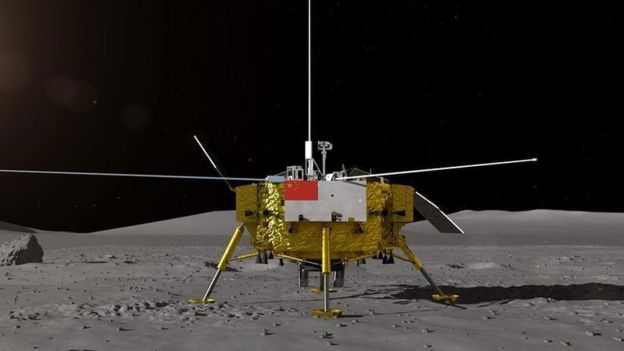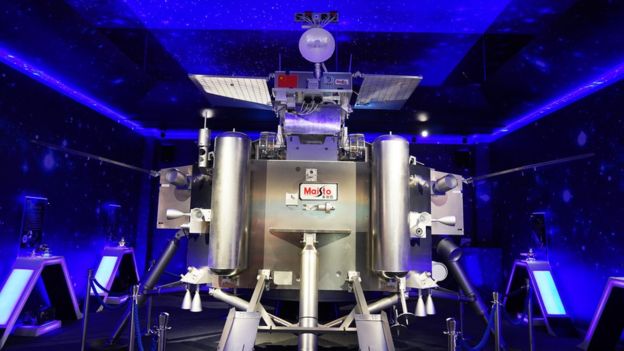China is preparing to make the first attempt at landing robotic spacecraft on the Moon’s far side. A static lander and rover are expected to be deployed to the surface in the next day, state media reports. The vehicles are carrying a suite of instruments designed to characterise the region’s geology, as well as a biological experiment. In recent days, the Chang’e-4 spacecraft had lowered its orbit in preparation for landing.
At the weekend, Chinese state media said the probe had entered an elliptical path around the Moon, bringing the vehicles to within 15km (9 miles) of the lunar surface at its closest point.
Authorities have not specified the exact time of the attempt to touch down in the Von Kármán crater. But a report in the state-run China Daily newspaper suggests Chang’e-4 could begin descending on its thrusters sometime from 2-3 January.
Targeting the far side turns this mission into a riskier and more complex venture than its predecessor, Chang’e-3 – which touched down in the Moon’s Mare Imbrium region in 2013. But China’s latest moon shot will pave the way for the country to deliver samples of lunar rock and dust to Earth.
Andrew Coates, professor of physics at UCL’s Mullard Space Science Laboratory in Surrey, told BBC News: “This daring mission will land nearly 50 years on from the historic Apollo landings and will be followed in late 2019 by a Chinese sample return mission.”
Because of a phenomenon called “tidal locking”, we see only one “face” of the Moon from Earth. This is because the Moon takes just as long to rotate on its own axis as it takes to complete one orbit of Earth.
The lunar far side is often referred to as the “dark side”, though “dark” in this case means “unseen” rather than “lacking light”. In fact, both the near and far sides of the Moon experience daytime and night-time.
But the far side has a thicker, older crust that is pocked with more craters. There are also very few of the “mare”
– dark basaltic “seas” created by lava flows – that are evident on the near side.
The Von Kármán crater is located within a much larger feature – the South Pole-Aitken (SPA) Basin – thought to have been formed by a giant impact early in the Moon’s history.
“This huge structure is over 2,500km in diameter and 13km deep, one of the largest impact craters in the Solar System and the largest, deepest and oldest basin on the Moon,” Prof Coates told me.
And therein lies the scientific interest. The event responsible for carving out the SPA basin is thought to have been so powerful, it punched through the outer layer of the Moon, known as the crust, and down into the zone called the mantle. Researchers will want to train the instruments on any mantle rocks exposed by the calamity.
The science team also hopes to study parts of the sheet of melted rock that would have filled the newly formed South Pole-Aitken Basin, allowing them to identify variations in its composition.
A third objective is to study the far side regolith, the broken up rocks and dust that make up the surface.
“The in-situ composition information in particular will be hugely valuable in understanding the formation of the Moon,” Andrew Coates commented.
Landing challenge
Up until now, China has followed in the footsteps of US and Soviet missions, carefully building up its capabilities. But this mission marks a first for any space agency. The rugged character of the far side, with its undulating topography, poses particular challenges for landing the vehicles safely.
Touching down on a jagged outcrop would spell instant mission failure – and be a significant setback for the Chinese exploration programme.
The selection of the Von Kármán crater as the landing site owes much to the fact that it’s flatter than any spot in the South Pole-Aitken basin, according to Chinese scientists. The descent to the lunar surface is split into six phases. The first three – initial deceleration, quick attitude and reorientation adjustment, and approach – will be controlled from Earth. For the final three – hovering, hazard avoidance, and slow descent – the lander will take over, assuming autonomous control.
The lander and rover were originally built as back-ups for 2013’s Chang’e-3 mission. However, they have received important modifications for the ambitious touchdown on the far side. Chang’e-4’s static lander is carrying two cameras; a German-built radiation experiment called LND; and a spectrometer that will perform low-frequency radio astronomy observations. Scientists believe the far side could be an excellent place to perform radio astronomy, because it is shielded from the radio noise of Earth. The spectrometer work will aim to test this idea.
The lander will also carry a 3kg (6.6lb) container with potato and arabidopsis plant seeds – as well as silkworm eggs – to perform biological studies. The “lunar mini biosphere” experiment was designed by 28 Chinese universities.
The rover will carry a panoramic camera; a radar to probe beneath the lunar surface; an imaging spectrometer to identify minerals; and an experiment to examine the interaction of the solar wind (a stream of energised particles from the Sun) with the lunar surface.
In an article for the US-based Planetary Society in September, Dr Long Xiao from the China University of Geosciences (Wuhan), said: “Chang’e-4 will be humanity’s first landed exploration of the lunar far side. The challenge faced by a far side mission is communications. With no view of Earth, there is no way to establish a direct radio link.”
Thus, the landers must communicate with Earth using a relay satellite named Queqiao, launched by China in May this year. Queqiao orbits 65,000km (40,000mi) beyond the Moon, around a Lagrange point – a kind of gravitational parking spot in space where it will remain visible to ground stations in China and other countries such as Argentina.
The lander and rover was launched from Xichang Satellite Launch Center in China on 7 December; the vehicles arrived in lunar orbit on 12 December. The mission is part of a larger Chinese programme of lunar exploration. The first and second Chang’e missions were designed to gather data from orbit, while the third and fourth were built for surface operations. Chang’e-5 and 6 are sample return missions, delivering lunar rock and soil to laboratories on Earth.

